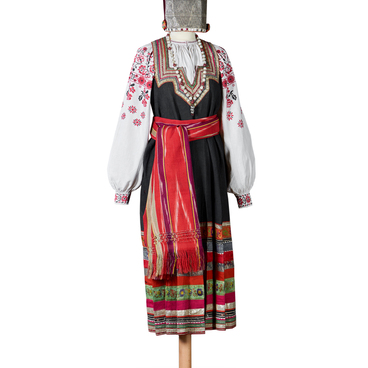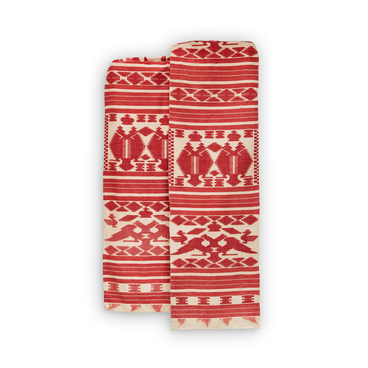The collection of the Belgorod State Historical and Local History Museum features a festive women’s costume — a paneva set of clothes from the village of Afanasyevka in the Biryuchensk district of the Voronezh province (now the Belgorod Region). It consists of a paneva skirt, a black-patterned shirt, an apron, a belt, a neck decoration called gribatka, a headdress called soroka, and shoes. Paneva was an integral part of the set of clothes and a unique symbol of the difficult fate of a married woman among the Slavic peoples. The first paneva was given to a girl by her mother, and often it was a special rite symbolizing the girl’s entry into adulthood.
A paneva was a closed homespun wool skirt made of three checkered panels and one black panel. The name of the paneva depended on its purpose and the embroidery it had. A paneva was called “pine, ” when the embroidery of its back panels resembled a tree, that is, the stitches diverged upwards on the sides.
The paneva provided warmth, which was important in a cold climate. The simple cut was compensated by rich decoration, which not only served to adorn, but also had a complex symbolic meaning. The color of the material and the checkers could indicate the woman’s origin. The three main colors revered by the Slavs were white, black, and red. Each woman had up to 10 panevas, and skilled craftswomen could have up to 20.
Part of the festive women’s costume was a shirt made of homespun hemp cloth with black-patterned cross-stitched embroidery forming a geometric pattern.
The main embroidery motifs were rhombuses, rhombuses with extensions, triangles, rosettes, solar signs, and diagonal crosses. The rhombus is a sign of life, and therefore of earth and fertility. A diamond divided into four parts is a symbol of a cultivated field, while a dot in the center of the square means a grain sign. Embroiderers placed such symbols on the upper part of the sleeves and shoulders of the shirt, and on woolen panevas — along the hips and shins, striving to endow the arms and legs with greater strength through this magical pattern. The number of patterns in the embroidery composition is not too large. The patterns are repeated, but in new combinations they are perceived as different designs.
An essential part of a woman’s costume, both festive and everyday, was an apron. Its original purpose was to protect the woman’s essence from the influence of evil forces. In the village of Afanasyevka, short aprons called zaveski were worn with the paneva.
Another mandatory element of the costume was a
belt. Most often, paneva was complimented by a narrow woolen belt with a pattern
in the form of longitudinal stripes of different colors and widths on a red
background. The ends of the festive belts were decorated with fringe.






